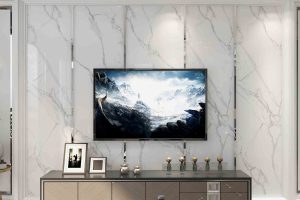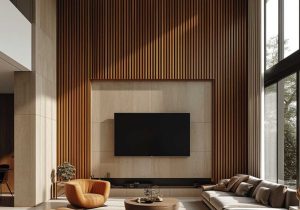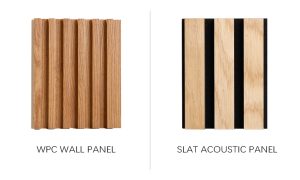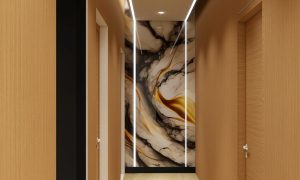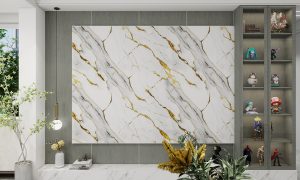Acoustic panels are designed to absorb sound waves, reducing noise, echo, and reverberation within a space. They are typically used in environments where controlling sound is important, such as recording studios, offices, theaters, and conference rooms. Here’s how they work and what they do:

Functions of Acoustic Panels:
- Sound Absorption: Acoustic panels absorb sound waves, preventing them from bouncing off hard surfaces like walls, floors, and ceilings. This helps in reducing the overall noise level in a room.
- Echo Reduction: By absorbing sound, acoustic panels minimize echoes, which can make it difficult to hear clearly in a room. This is particularly beneficial in spaces where clear communication is crucial.
- Reverberation Control: Acoustic panels help control reverberation time, which is the time it takes for sound to decay in a space. This creates a more comfortable and acoustically balanced environment.
- Improved Sound Quality: In spaces like recording studios or home theaters, acoustic panels enhance sound quality by providing clearer audio and better acoustics.
- Speech Clarity: In offices and conference rooms, acoustic panels improve speech intelligibility, making it easier for people to communicate without the distraction of background noise.
Construction and Materials
- Foam Panels:
- Material: Made from open-cell polyurethane foam.
- Features: Lightweight, easy to install, effective at absorbing mid to high-frequency sounds.
- Applications: Common in home studios, vocal booths, and small rooms.
- Fiberglass Panels:
- Material: Composed of dense fiberglass wrapped in fabric.
- Features: Higher density than foam, better absorption of a wider range of frequencies including low frequencies.
- Applications: Professional studios, auditoriums, and larger spaces requiring comprehensive sound control.
- Mineral Wool Panels:
- Material: Made from compressed mineral wool, often wrapped in fabric.
- Features: Similar to fiberglass panels in density and absorption properties.
- Applications: Industrial environments, studios, and other areas needing robust sound absorption.
- Perforated Wood Panels:
- Material: Wood with perforations or slots to allow sound to pass through and be absorbed by an underlying acoustic material.
- Features: Combines aesthetic appeal with sound absorption.
- Applications: Conference rooms, theaters, and spaces where design is important.
- Fabric-Wrapped Panels:
- Material: A variety of acoustic cores (foam, fiberglass, mineral wool) wrapped in fabric.
- Features: Available in different colors and textures, allowing for aesthetic integration.
- Applications: Offices, classrooms, restaurants, and residential areas.
Types and Forms

- Wall Panels:
- Mounted directly on walls.
- Used to control reflections and echoes in various settings.
- Ceiling Panels and Clouds:
- Suspended from the ceiling.
- Effective in controlling reverberation in large, open spaces such as gyms and auditoriums.
- Bass Traps:
- Placed in corners where low-frequency sound tends to build up.
- Essential for controlling bass in recording studios and home theaters.
- Diffusers:
- Scatters sound waves rather than absorbing them.
- Used in combination with absorptive panels to create a balanced acoustic environment.
Installation and Placement
- First Reflection Points:
- Place panels at points where sound first reflects off walls (typically side walls and ceiling).
- Use mirrors to find these points: if you can see the speakers in a mirror from your listening position, that’s a reflection point.
- Corners:
- Place bass traps in corners to absorb low-frequency buildup.
- Ceiling corners (where walls meet the ceiling) are also effective places for bass traps.
- Back Wall:
- Panels on the back wall help reduce echoes and reflections.
- Useful in home theaters and listening rooms.
- Ceiling:
- Use ceiling clouds to control reflections from above.
- Effective in open spaces and rooms with high ceilings.
Specific Applications
- Recording Studios:
- Require a combination of absorptive panels, bass traps, and diffusers for a balanced sound environment.
- Control both direct sound and reflections for clear recordings.
- Home Theaters:
- Use absorptive panels to minimize reflections and enhance clarity of dialogue and sound effects.
- Bass traps ensure even bass response throughout the room.
- Offices and Conference Rooms:
- Panels improve speech intelligibility and reduce noise distractions.
- Enhance productivity and communication.
- Educational Institutions:
- Classrooms and lecture halls benefit from reduced reverberation and clearer speech.
- Creates a better learning environment.
- Public Spaces:
- Restaurants, cafes, and lobbies use acoustic panels to create a more comfortable atmosphere.
- Reduce background noise and enhance overall ambiance.
Performance Metrics
- Noise Reduction Coefficient (NRC):
- A measure of how much sound a panel can absorb.
- Ranges from 0 (no absorption) to 1 (total absorption).
- Sabins:
- A measure of total sound absorption of a panel.
- Takes into account the panel’s size and absorption characteristics.
- Frequency Response:
- Indicates which frequencies a panel is most effective at absorbing.
- Important for matching panel types to the specific needs of the room (e.g., bass traps for low frequencies).
Do Acoustic Panels Work?

Yes, acoustic panels work effectively when used correctly. They can significantly improve the acoustics of a space by reducing noise levels, controlling echoes, and enhancing sound quality. Proper selection, placement, and quantity of acoustic panels tailored to the specific needs of the room will yield the best results.
For more information, you can contact us anytime!

